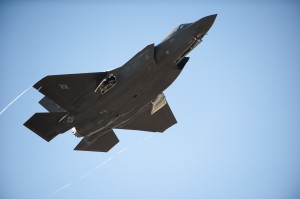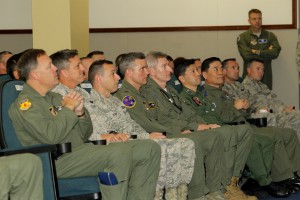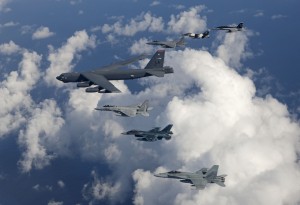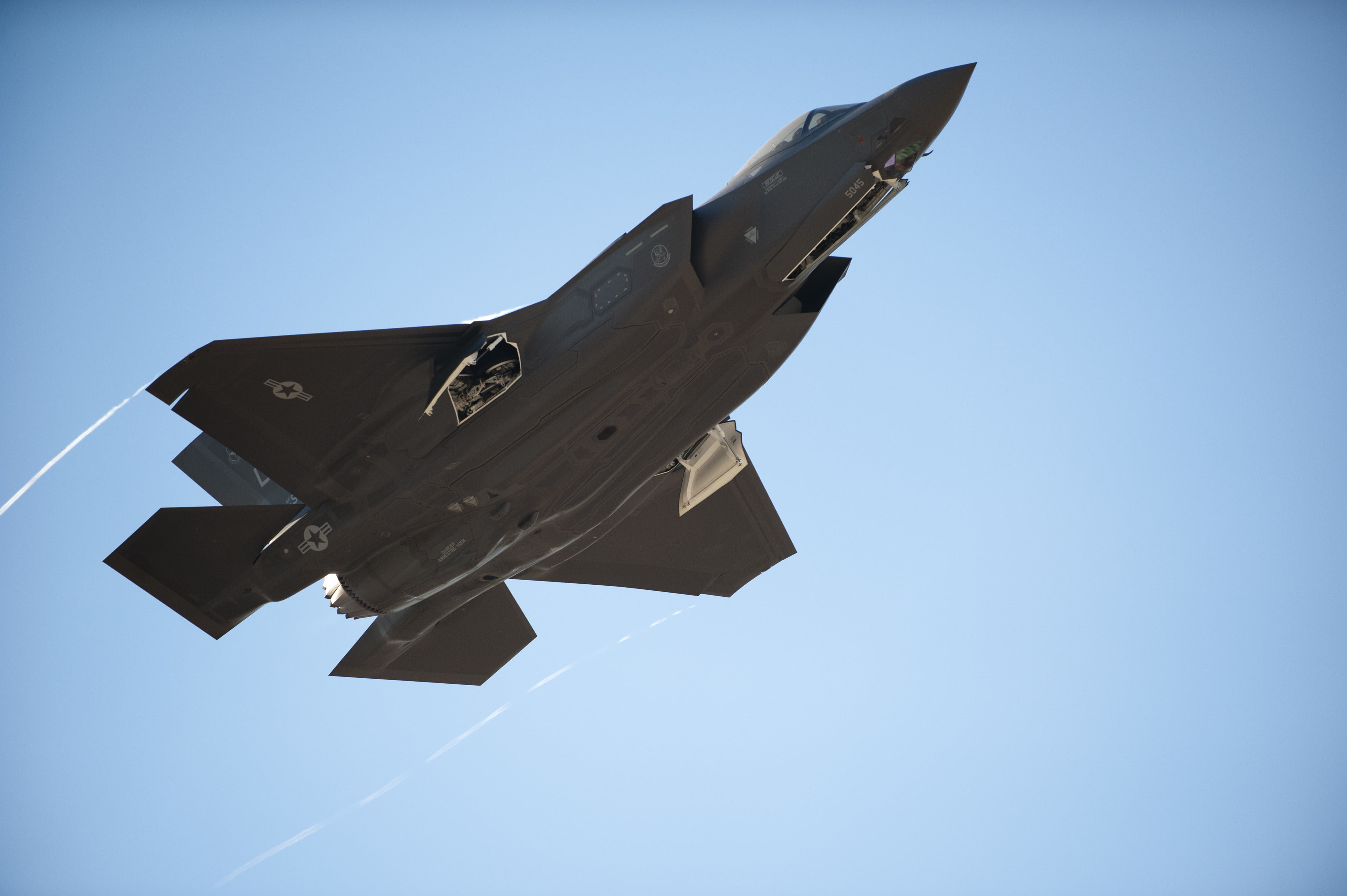2015-11-13 By Robbin Laird
The first flight of Italian F-35 pilots occurred on November 5, 2015.
The two pilots flew a USAF and a RAAF jet. The flight aboard the Australian jet highlighted the role of the partners in the F-35 program, and a harbinger of things to come.
As the Italian pilots highlighted in an interview after the flights:
Question: You flew an Australian jet yesterday.
You do not normally work with Australian pilots, but you will get to know them from the ground up as well as you train at Luke and fly each other’s jets.
What is your sense of this dynamic?
Answer: The young guys will grow up in a very advanced warfighting and multi-national environment because of this program.
They will be used to not just working together from time to time in an exercise, but will build in common tactics from the ground up and help each other innovate as well.
https://sldinfo.com/italy-and-two-historic-first-flights-in-2015-shaping-the-f-35-global-enterprise/
The partners, the USMC, the USN and the USAF is learning to fly their most advanced jet AT PRECISELY THE SAME TIME as key allies.
Put bluntly, rather than learning to fly WITH the U.S. services on different jets, the Italians and other F-35 nations are shaping common training, tactics and procedures for a global fleet FROM THE GROUND UP.
To get a sense from the Australian point of view of the event and it’s meaning, I had a chance to discuss the Australian experience with Group Captain Glen Beck, Director of the Air Combat Transition Office in the Royal Australian Air Force.
He is responsible for how the RAAF transitions its air combat elements, and is primarily focused on the introduction of the F-35 as well as the Growlers into the force. He is the senior F-35 pilot in the transition, which means that the pilots at Luke AFB involved in F-35 training report to him.

A bio of Group Captain Beck can be found at the end of the interview.
“The way we think about it is that we are not focused simply on the platforms but upon the evolution of air combat capabilities as we introduce the new platforms. It is about balancing the strengths over time of the various platforms and looking at balance and complementary capabilities among the air platforms, such as Super Hornet, F-35, Growler and Wedgetail.”
Question: How important is it to get in on the ground floor with the F-35 and working together with the partners?
Group Captain Beck: The model being shaped at Luke is standing up critical mass with integrated USAF and partner efforts. It is a much better model than several small groups nationally trying to work it out for themselves.
It also means that the users can speak with one voice about the development of the program, and what is working and what is not working.
This allows us to address ways to improve things like the working of ALIS, how the maintainers work together, how to maintain and sustain, how the spare parts pool can work more efficiently, how to improve IT support, etc.
The critical mass can work towards a common set of solutions, rather than everyone coming at it from very different angles.
This makes approaches to change more coherent.
It allows us to prioritize tasks to be dealt with at the project level as well in moving ahead with training.
Question: The Italian pilots highlighted the importance of sharing common TTPs.
How important is this from your point of view?
Group Captain Beck: It is important to have shared understanding.
It is about the end state you are driving towards.
It is about interoperability for the warfighter.
If you can shape that understanding as you are learning the system then you are setting yourself up for better combat success in the future.

Question: How is the Luke AFB process helping shape this common approach?
Group Captain Beck: We are in the 61st Fighter Squadron with the USAF.
The guys there are finding it relatively seamless working with the USAF in the squadron. We have many commonalities in how we train, think and operate.
As far as the Italians and the Norwegians at with the 62nd Fighter Squadron working with the USAF.
We will have less day-to-day interactions with the Italians and Norwegians, but the way the program is set up you could have Australian instructors and students working with the 62nd Fighter Squadron as well as the reverse.
http://flightlines.airforcetimes.com/2015/06/22/luke-stands-up-new-f-35-squadron/
We are working with the same curriculum and syllabus within the program.
Question: You are working critical mass not just from a pilot perspective but from the air systems perspective.
Is that how to look at it?
Group Captain Beck: It is. Not everyone has enough jets at the beginning but by being part of a coalition critical mass they have access to more than simply their own national jets.
By putting the various national participants in a common pool you can accelerate learning and shape more effective solutions from the beginning.
And we are seeing a clear acceleration of this process, something not easily recognized by those not participating in the program.
And with the growing numbers of F-35 pilots and maintainers, you will bring fifth generation into the main stream. Rather than simply being a niche capability, it will become the mainstay for change for the air combat force.
It is going to become more of a day-to-day experience; it is going to become less “special” and more normal.

A lot of people don’t realize how much momentum we have in the program and we are rapidly achieving critical mass in the program.
This will be the premier fighter in the 21st century; several nations will be using it; and sharing their combat experiences, and building an evolving capability over time. In my opinion, a lot of people are yet to think through what the impact of this will mean.
Question: And the capability of partners and allies to work through their own ways ahead will be enhanced as well.
How do you view the regional opportunities inherent in the program?
Group Captain Beck: There is a clear capability to work to build greater regional collaboration as well. Instead of a FMS approach to buying a US system, the F-35 is more of a global network of depots, suppliers and there are opportunities to collaborate as well regionally from an ownership of capability perspective.
Bio – Group Captain Glen Beck
Current Responsibilities
The position of Director Air Combat Transition Office (DACTO) retains overall responsibility for coordination of the RAAF’s air combat transition composing F18F, F18G and JSF. DACTO is specifically responsible for introduction to service of the F-35A as a representative of the Capability Manager in the Australian JSF Division Integrated Project Team.
Previous Service
Group Captain Glen Beck was born in Melbourne in 1969. Upon completing high school he attended the University of Melbourne for one year before joining the RAAF in 1989. Group Captain Beck continued his studies at the Australian Defence Force Academy and graduated with a Bachelor of Science degree in 1990.
After completing No. 158 Pilot’s course, Group Captain Beck progressed to 3 SQN to fly the F/A-18. At the completion of his first flying tour he became a Qualified Flying Instructor and instructed at 2FTS in Pearce, followed by teaching F/A-18 conversion course at 2OCU.
In 2003 Group Captain Beck saw combat action over Iraq with 75 SQN, and shortly after returning became the Executive Officer (XO) at 3 SQN. In 2006 Group Captain Beck attended Staff College in Toronto, Canada, where he earned a Master of Defence Studies Degree. Upon returning to Australia he was promoted to Wing Commander and spent 2 years in Capability Development Group, doing fast jet project work in Canberra.
Group Captain Beck was appointed Commanding Officer of No. 77 Squadron from 30 June 2009 until 14 January 2013, for which he was awarded the Conspicuous Service Cross. He was promoted to Group Captain and appointed Chief of Staff for Air Combat Group for two years until his present DACTO role commenced in January 2015.
Group Captain Beck has approximately 4500 flying hours including more than 3000 on the F/A-18.
Editor’s Note: Group Captain Beck was involved in last year’s Cape North exercise which is discussed in this USAF piece published on 2/16/14.
| By Tech. Sgt. Zachary Wilson Pacific Air Forces Public Affairs2/16/2014 – ANDERSEN AIR FORCE BASE, Guam — More than 1,800 service members and approximately 50 aircraft from the U.S. Air Force, U.S. Navy, Japan Air Self-Defense Force, Royal Australian Air Force and Republic of Korea Air Forces came together to kick off the 85th iteration of Pacific Air Forces’ Cope North exercise Feb. 14 on Andersen Air Force Base, Guam.The trilateral field training exercise features a full spectrum of fighters, bombers, transport, re-fueling and command and control aircraft from the U.S., JASDF, and RAAF designed to improve combat readiness, develop a synergistic disaster response, and increase interoperability between partner nations.Also as part of Cope North 14, Republic of Korea Air Force will join with the other nations to conduct humanitarian assistance and disaster relief training.”Cope North is a tremendous opportunity for nations in our region to train together at Andersen building a common set of tactics, techniques and procedures” said Brig. Gen. Steven Garland, 36th Wing Commander. “We live in a very dynamic region of the world and the Airmen participating this year in our largest Cope North to date, all recognize the value provided to the region from great team work.” The flexibility and rapid response exhibited during the recent Philippine typhoon relief effort of Operation Damayan underscores the value of training opportunities during times of relative calm so nations are prepared to respond in times of crisis to support their nation,” said Garland. Exercise directors representing each nation’s component all remarked on the uniqueness and quality of Andersen’s infrastructure, facilities and the Central Marianas airspace the units will use during the two-week exercise. “We have great facilities, great airspace here and this exercise is all about getting better, learning from each other and doing it safely,” said Col. John Parker, U.S. Cope North exercise director and 35th Operations Group commander at Misawa Air Base, Japan. The three participating countries each feature an exercise director, leadership teams, planning sections, aviators, maintenance and other support members, said Maj. Micah Bell, an exercise planner from 5th Air Force at Misawa. Through interoperability, the three teams each assume the lead on various operations throughout the exercise and work closely with their counter-parts.  “Interoperability is a word that gets used often during this exercise,” he said. “We take that very literally; we want to not only get safe, effective training, but also want to learn from our partners and share lessons learned.” The exercise is unique in that it combines air-to-air and air-to-ground combat training with allied partners and additionally incorporates a humanitarian aid and disaster response portion concurrently. “We live in a region with lots of natural disasters,” said Group Capt. Glen Beck, RAAF exercise director. “The (Australian Air Force) isn’t very large so we are always grateful for training opportunities; this is the largest international exercise we do and it’s definitely the largest footprint.” Col. Hiroshi Kurata, serving as exercise director for JASDF, noted the significance of both training for disaster and building professional relationships. “It’s been three years since the earthquake hit eastern Japan and I appreciate all the support and cooperation we received during Operation Tomodachi,” he said. “Additionally, I ask three things from all in attendance here: Do your best, enjoy your job and make as many friends as possible.” |


